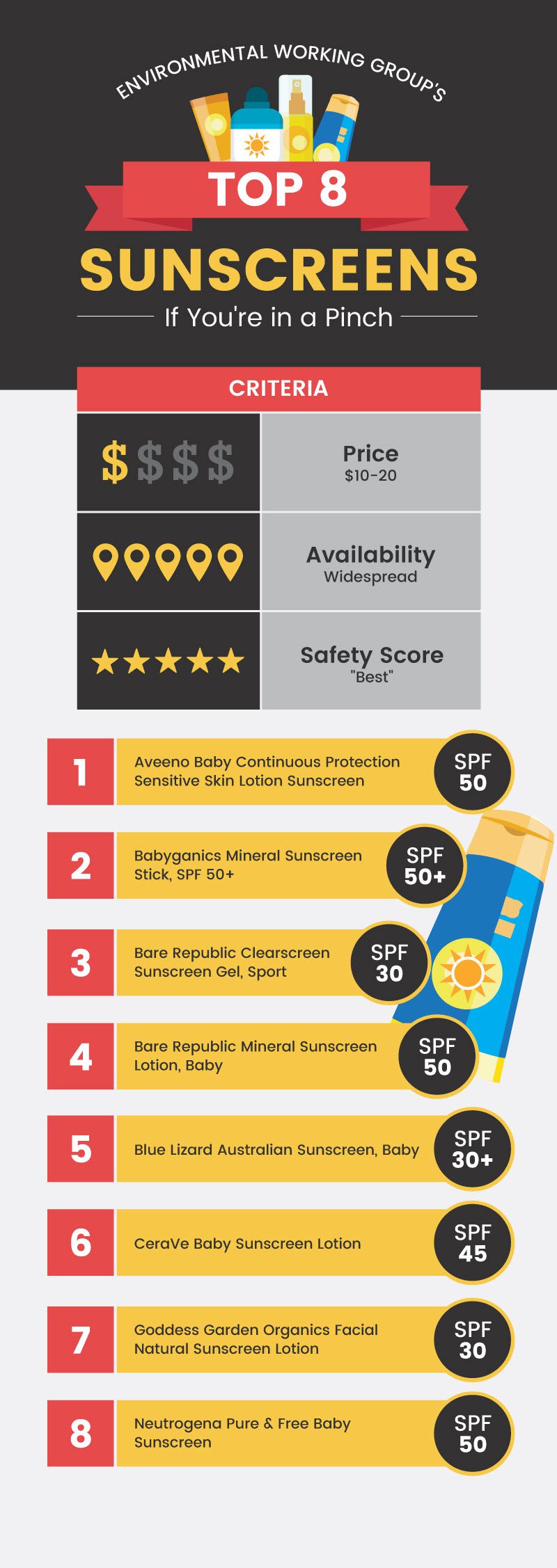
It’s no secret that the sun (in moderate doses) provides all sorts of health benefits, including helping our bodies manufacture vital vitamin D.
With beach season right around the corner, though, many people are looking for the best sunscreens to cut their risk of sun overexposure, sunburns, and possibly skin cancer.
The issue? All sunscreens are not created equally.
A 2019 report from Environmental Working Group (EWG) found that nearly two-thirds of sunscreens don’t work and contain concerning ingredients that are readily absorbed by the body.
A recent study found that sunscreen chemicals hit the bloodstream within a day of using them, and at levels high enough to prompt a government investigation on safety.
This is EWG’s 13th Annual Guide to Sunscreens report, and the results show that while there have been significant improvements over the last decade,
the vast majority of sunscreens available for purchase in the U.S. still contain damaging chemicals or fail to offer enough protection against ultraviolet rays.
And here’s the part that gets me:
About half of the beach and sport sunscreens sold in the U.S. that EWG analyzed would not be allowed on the market in Europe due to inadequate protection against UVA rays.
But there is positive movement on the sunscreen front…
Are You Using the Best Sunscreens?
EWG has been pushing the Food and Drug Administration to update and improve its sunscreen regulations for years to protect public health better.
Now, the FDA is finally taking up the issue and proposing significant changes to sunscreens.
The downside? This is all still in the works, so it doesn’t pertain to sunscreens on the market for the 2019 season.
As unbelievable as this may seem, the FDA started updating sunscreen rules more than four decades ago.” In February, the agency at long last issued a proposed set of final regulations.
As written, the new rules would bring significant advances in both effectiveness and safety,” EWG reports.
“But many big chemical manufacturers and sunscreen companies are lobbying heavily for a much weaker proposal that would likely leave the state of sunscreens in the U.S. largely unchanged.”
Stay tuned to see how this pans out for the 2020 season.
And then there’s the UVA dilemma…
A past EWG report cited the research of Brian Diffey, Ph.D., emeritus professor of photobiology at the Institute of Cellular Medicine at Newcastle University.
He’s shown that, on average, U.S. sunscreens allow about three times more UVA rays to transfer through skin compared to European sunscreens.
Americans’ sunscreen choices are fewer and often offer worse UVA protection compared to those available in the European Union.
This matters because UVA rays are more abundant than UVB rays, and UVA damage is more subtle than the sunburns induced mainly by UVB rays.
UVA rays can damage your skin invisibly by suppressing the immune system and aging the skin over time;
overexposure of these rays is also linked to the development of melanoma, squamous cell carcinoma, and basal cell carcinoma, too.
In a newly proposed rule from the FDA, the agency is finally voicing concern about the role of UVA rays in the development of skin cancer.
It stated that “UVA exposure is a significant concern,” and high SPF products currently on the market may expose users to “excessively large UVA doses.”
Now, it’s important to note that there is no perfect sunscreen.
Many contain harmful chemicals, and even mineral-based ones often contain nanoparticles, minute ingredients that can cross the blood-brain barrier, and also harm aquatic life.
Beyond that, sunscreen is unique compared to many other personal care products because you coat it thickly onto your skin, often multiple times a day.
You don’t get that type of hours-long, skin-absorbing exposure with something like, say, the shampoo you quickly wash off.
That’s why it’s crucial to look for safer sunscreens if you use them and to recognize that you can’t only rely on sunscreens alone to prevent sun overexposure.
“No product is going to be fully protected, and no product will last on your skin for more than two hours max,” explains Lunder.
She says thickly applying sunscreen coatings, reapplying every time you’re out of the water, and choosing a better product, to begin with, are all key.
But other sun-smart methods to avoid overexposures are a must. More on those later.
In the EWG’s 2019 best sunscreens report, the group analyzed the ingredients, and labeling claims more than 1,300 products with SPF, including 750 sport and beach sunscreens.
So what are the best sunscreens out there? Let’s take a look.
The Best Sunscreens of 2019, Beach & Sport
- Attitude 100% Mineral Sunscreen, Fragrance-Free, SPF 30
- All Good Sunstick, Unscented, SPF 30
- Aveeno Baby Continuous Protection Lotion Sunscreen, Sensitive Skin, SPF 50
- Badger Active Natural Mineral Sunscreen Cream, Unscented, SPF 30
- Goddess Garden Sport Mineral Sunscreen Lotion, SPF 50
- Just Skin Food Baby Beach Bum Sunscreen Stick, SPF 31
- Kabana Organic Skincare Green Screen Sunscreen Lotion, Original, SPF 32
- Poofy Organics The Sunscreen Lotion, SPF 30
- Poofy Organics The Sunscreen Stick, SPF 30
- Sunology Mineral Sunscreen, Body, SPF 50
- Thinksport Sunscreen, SPF 50+
- Waxhead Sun Defense Zinc Oxide Sunscreen Stick, SPF 30
The Best Sunscreens of 2019, Moisturizers
- Badger Damascus Rose Face Sunscreen, SPF 25
- Block Island Organics Natural Face Moisturizer, SPF 30
- Drunk Elephant Umbra Sheer Physical Daily Defense, SPF 30
- Goddess Garden Face the Day Daily Moisturizer, SPF 30
- Juice Beauty Oil-Free Moisturizer, SPF 30
- Share Shaded Rose Solar Calming Facial Cream, SPF 30
- Suntegrity Skincare Natural Moisturizing Face Sunscreen & Primer, SPF 30
The Best Sunscreens of 2019, Kid-Friendly
- Adorable Baby Sunscreen, SPF 30+
- All Good Kid’s Sunscreen, SPF 30
- Aveeno Baby Continuous Protection Sensitive Skin Zinc Oxide Sunscreen Lotion, SPF 50
- Badger Kids Active Sunscreen Cream, Tangerine & Vanilla, SPF 30
- Bare Republic Baby Mineral Sunscreen Lotion, SPF 50
- Blue Lizard Australian Sunscreen, Baby, SPF 30+
- BurnOut Kids Sunscreen, SPF 35
- California Baby Calendula Sunscreen, SPF 30+
- COOLA Suncare Baby Mineral Sunscreen Stick, SPF 50
- Equate Baby Zinc Sunscreen Mineral Lotion, SPF 50
- Goddess Garden Kids Mineral Sunscreen Lotion, SPF 50
- Hawaiian Sol Sol Kid Kare, SPF 50
- MDSolarSciences KidCreme Mineral Sunscreen, SPF 40
- Neutrogena Pure & Free Baby Sunscreen, SPF 50
- Nurture My Body Baby Organic Sunscreen, SPF 32
- Sunology Mineral Sunscreen, Kids, SPF 50
- thinkbaby Sunscreen, SPF 50+
- thinksport Kids Sunscreen, SPF 50+
- Tom’s of Maine Baby Sunscreen Lotion, Fragrance-Free, SPF 30
- Waxhead Sun Defense Baby Zinc Oxide Sunscreen, SPF 35
Most Toxic Sunscreens to Avoid
Children are more susceptible to certain toxic chemicals during development, and because blistering sunburns early in life can lead to an increased risk of skin cancer down the line.
That’s why it’s even more vital for children and babies to avoid the most toxic sunscreens.
While other brands received low scores, too, here are some of the children and baby sunscreen products with the worst ratings.
Worst Sunscreens for Kids
- Banana Boat Kids Continuous Spray Sunscreen, SPF 100
- Banana Boat Kids Sunscreen Lotion, SPF 100
- Coppertone Water Babies Sunscreen Lotion Spray, SPF 50
- Coppertone Kids Sunscreen Spray, SPF 50
- Coppertone Kids Wet Protect Sunscreen Spray, SPF 50
- CVS Health Children’s Clear Spray, SPF 50 and 70
- Equate Baby Sunscreen Lotion, SPF 70
- Neutrogena Wet Skin Kids Stick Sunscreen/Spray, SPF 70+
- Up & Up Kids Sunscreen Spray, SPF 50
And here are some of the other worst overall offenders scoring in the Red Zone (7-10) for major safety concerns:
- Panama Jack Sport Sunscreen Lotion, SPF 50+ & 85
- Neutrogena Sensitive Skin Sunscreen, SPF 60+
- CVS Health Sensitive Skin Sun Lotion, SPF 60+
- Up & Up Sport Sunscreen Spray, SPF 15, 30 & 50
- Panama Jack Sunscreen Spray, SPF 15, 30 & 70
- NO-AD Sun Care Sport Continuous Spray Sunscreen, SPF 50
- Neutrogena Wet Skin Sunscreen Spray, SPF 50 & 85+
- Neutrogena Ultra Sheer Sunscreen Spray, SPF 30
- Neutrogena Ultra Sheer Body Mist Sunscreen Spray, SPF 100+
- Neutrogena Ultra Sheer Dry-Touch Sunscreen, SPF 70, 85+ & 100+
Key Findings in EWG’s Sunscreen Report
- About half the sunscreen products sold in the U.S. wouldn’t pass the more stringent European standards because they don’t filter enough UVA rays.
- Despite strong evidence to show sunscreens can even prevent skin cancer, it’s still legal for most sunscreens to make cancer prevention claims.
- Nearly 67 percent of sunscreen products reviewed by EWG either didn’t work adequately to protect from UV rays, or they contained dangerous ingredients. Some of the most worrisome ingredients include oxybenzone, one of the known endocrine disruptors, and retinyl palmitate, a form of vitamin A that may harm the skin and possibly lead to skin tumors.
- Oxybenzone is in widespread use in American chemical-based sunscreens. Lab testing shows skin penetration rates of 1 to 9 percent. That’s concerning, given the fact that it acts like an estrogen in the body and is linked to abnormal sperm function in animal studies and endometriosis in studies of women. Oxybenzone also acts as a skin allergen in a significant number of people. (So does methylisothiazolinone, a common sunscreen preservative found in the majority of products surveyed.) Thankfully, the state of Hawaii has the opportunity to ban oxybenzone in sunscreen due to its ability to bleach and kill coral reefs.
- From 2007 to 2018, there has been a 41 percent rise in mineral sunscreens in the United States. These sunscreens tend to block UVA better than chemical sunscreen ingredients and also manage to be rated safer on EWG’s sunscreen database.
- In EWG’s 2010 review, about 40 percent of sunscreens contained vitamin elements. This type of ingredient can react with UV rays and increase the risk of skin tumors, according to government animal testing data.
- Scientists don’t know for sure if sunscreen helps prevent melanoma. In fact, as EWG notes in its executive summary of the sunscreen guide, “Sun exposure appears to play a role in melanoma, but it is a complex disease for which many questions have not been answered. One puzzling fact: Melanomas do not usually appear on parts of the body that get daily sun exposure.”
- Be wary of ultra-high SPF claims. There are more of them today than several years ago. The U.S. hasn’t approved common sunscreen ingredients that would do a better job of broad-spectrum protection. Because of this, UVA protection is often lacking in SPF 70+ products. In other developed countries, SPF is usually capped at 50.
- I suggest steering clear of spray sunscreens. It’s tough to apply in a thickness that will provide adequate protection, plus, it increases the risk you’re sending sunscreen chemicals directly into your lungs (and the lungs of everyone sitting around you.)
- Nearly 30 percent of sunscreens tested were spray sunscreens in 2018, up from about 20 percent in 2007. These sprays pose an inhalation risks and are hard to actually apply correctly. (Even the Food and Drug Administration raised concerns about spray sunscreens, although the agency hasn’t banned them yet.)
- FDA banned the use of misleading sunscreen bottle claims like “waterproof” and “sweatproof” in 2011, but Lunder says other misleading marketing terms are still in use. These include things like “sun shield” and “age shield.” Lunder says these marketing terms imply complete protection, reassuring someone that it’s all they need to protect their skin. That is simply not true.
- If you avoid the sun, get your vitamin D levels checked at your health care provider. A growing number of the population is deficient, thanks to sunscreens and spending more time indoors.
The good news is you can get enough vitamin D and protect yourself from burns without always turning to sunscreen.
How to Avoid Too Much Sun (Without Sunscreen)
Getting some sun exposure is vital for good health because it helps your body create vitamin D. There are multiple ways to get vitamin D, but your best bet is to get it from standing in the sun or eating vitamin D-rich foods. Sitting in the sun unexposed for about 10 minutes helps your body create roughly 10,000 units of natural vitamin D.
Vitamin D deficiency has been linked to certain cancers, autoimmune diseases, heart disease depression, osteoporosis, and many other ailments, so it’s essential to get enough. Like almost anything, though, you can get too much of a good thing and want to make sure you avoid sunburns.
You should consider sunscreen your last resort to prevent sunburns, though. There’s no clear evidence that using sunscreens actually prevent skin cancer — including in the best sunscreens — and some ingredients may fuel skin cancer.
Avoiding overexposure during peak sunlight hours, use sunglasses, and sun-protective hats and clothing (Solumbra is a good brand). These things reduce your risk of burns without sunscreen.
EWG Sunscreens: 8 Best Sunscreens That Are Cheap & Widely Available
EWG sunscreen ratings serve as a lifeline for people who want to use sunscreen without all of the toxic ingredients. For more than a decade, EWG (the non-profit Environmental Working Group) takes on the annual task of sifting through sunscreen label claims, ingredient lists, and scientific studies analyzing what’s really in those sunblock bottles.
Unfortunately, many of the highest-rated sunscreens aren’t readily available in chain grocery and drug stores, meaning it can be a little tricky finding a safe and effective sunscreen if you’re on the road and forgot yours at home. With that in mind, the EWG sunscreen team released a list of the safest, most reasonably priced sunscreens that are widely available in box stores around the country.
Now, to be clear, I believe the sun can be incredibly healing in the right dose, especially when it comes to avoiding vitamin D deficiency. But you don’t want to overdo it and suffer a damaging burn.
The most recent list consists of sunscreens that:
- Ranges in price from $10 to $20
- Received “best” ratings from the EWG sunscreen guide
- Are widely available in mainstream retailers and box store
Final Thoughts
- Thankfully, the FDA is finally proposing sweeping new rules that would make sunscreens in the U.S. safer and more effective. However, there’s a vast chemical lobby pushing back against that. We’ll stay on top of new developments as they emerge.
- When direct sunlight hits our skin under peak conditions, our bodies manufacture high levels of vitamin D. Not getting enough vitamin D has been linked to all sorts of health problems, including cancer, arthritis, depression and other diseases.
- However, you can get too much of a good thing, which is why it’s essential to take steps to prevent overexposure and sunburns.
- There is no perfect sunscreen, and this is clear from EWG’s 13th Guide to Sunscreens report. Mineral sunscreens generally rate safer, but they often contain nanoparticles that are not tightly regulated or studied for long-term impact on human or aquatic health. Chemical sunscreens often contain hormone-disrupting chemicals or even an ingredient that could trigger skin cancer. Still, EWG’s report helps consumers seeking sunscreen find safer choices while avoiding the most poorly rated brands.
- Sunscreen should be used as a last resort. Sun-protective measures like hats, sunglasses, seeking shade, and avoiding peak sunlight for extended periods should be used before turning to sunscreen, and when you do choose sunscreen, make sure it’s one of the best sunscreens.









